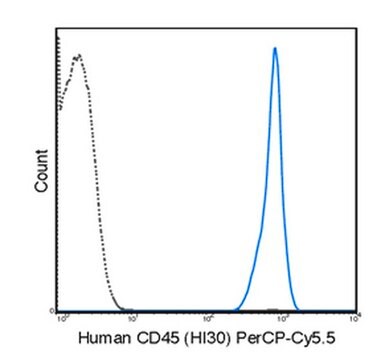MAB5450
Anti-Tau Antibody, phosphoThreonine 231, clone PHF-6
ascites fluid, clone PHF-6, Chemicon®
Zaloguj sięWyświetlanie cen organizacyjnych i kontraktowych
About This Item
Kod UNSPSC:
12352203
eCl@ss:
32160702
NACRES:
NA.41
Polecane produkty
pochodzenie biologiczne
mouse
forma przeciwciała
ascites fluid
klon
PHF-6, monoclonal
reaktywność gatunkowa
human
producent / nazwa handlowa
Chemicon®
metody
ELISA: suitable
western blot: suitable
izotyp
IgG1
numer dostępu NCBI
numer dostępu UniProt
Warunki transportu
dry ice
docelowa modyfikacja potranslacyjna
phosphorylation (pThr231)
Specyficzność
Reacts with human Tau phosphorylated at threonine 231 and fetal tau. The antibody also reacts with dephosphorylated neurofibrillary tangles. MAB5450 is reactive with the Thr231 phosphorylated and diphosphorylated peptides. No reactivity with normal adult tau or with unphosphorylated or serine 235 phosphorylated protein.
Immunogen
Epitope: phosphoThreonine 231
Paired helical filaments tau preparation from human brain.
Zastosowanie
Anti-Tau Antibody, phosphoThreonine 231, clone PHF-6 is an antibody against Tau for use in ELISA & WB.
Research Category
Neuroscience
Neuroscience
Research Sub Category
Neurodegenerative Diseases
Neurodegenerative Diseases
Western blot: 1:1000, non-phosphate buffers recommended. Specific for phospho-tau however highly phosphorylated blocking materials like non-fat milk can sometimes cause difficulties, thus we generally recommend blocking western blots with TBS-1-2% BSA solutions (filtered through a 0.45μm membrane) for better results.
Immunohistochemistry: fresh frozen tissues with Tris-NaCl-Triton treatment
{http://www.jhc.org/cgi/content/full/48/12/1627} & http://ajp.amjpathol.org/cgi/content/full/160/6/2045
Optimal working dilutions must be determined by end user.
Immunohistochemistry: fresh frozen tissues with Tris-NaCl-Triton treatment
{http://www.jhc.org/cgi/content/full/48/12/1627} & http://ajp.amjpathol.org/cgi/content/full/160/6/2045
Optimal working dilutions must be determined by end user.
Postać fizyczna
Liquid.
Przechowywanie i stabilność
Maintain at -20°C in undiluted aliquots for up to 12 months after date of receipt. Avoid repeated freeze/thaw cycles.
Informacje prawne
CHEMICON is a registered trademark of Merck KGaA, Darmstadt, Germany
Oświadczenie o zrzeczeniu się odpowiedzialności
Unless otherwise stated in our catalog or other company documentation accompanying the product(s), our products are intended for research use only and are not to be used for any other purpose, which includes but is not limited to, unauthorized commercial uses, in vitro diagnostic uses, ex vivo or in vivo therapeutic uses or any type of consumption or application to humans or animals.
This page may contain text that has been machine translated.
Kod klasy składowania
10 - Combustible liquids
Klasa zagrożenia wodnego (WGK)
WGK 1
Temperatura zapłonu (°F)
Not applicable
Temperatura zapłonu (°C)
Not applicable
Certyfikaty analizy (CoA)
Poszukaj Certyfikaty analizy (CoA), wpisując numer partii/serii produktów. Numery serii i partii można znaleźć na etykiecie produktu po słowach „seria” lub „partia”.
Masz już ten produkt?
Dokumenty związane z niedawno zakupionymi produktami zostały zamieszczone w Bibliotece dokumentów.
Aggregates of small nuclear ribonucleic acids (snRNAs) in Alzheimer's disease.
Hales, CM; Dammer, EB; Diner, I; Yi, H; Seyfried, NT; Gearing, M; Glass, JD; Montine et al.
Brain Pathology null
Quantitative phosphoproteomics of Alzheimer's disease reveals cross-talk between kinases and small heat shock proteins.
Dammer, EB; Lee, AK; Duong, DM; Gearing, M; Lah, JJ; Levey, AI; Seyfried, NT
Proteomics null
G T Bramblett et al.
Neuron, 10(6), 1089-1099 (1993-06-01)
Abnormally phosphorylated tau proteins (A68) are the building blocks of Alzheimer's disease (AD) paired helical filaments. The biological consequences of the conversion of normal adult tau to A68 remain unknown. Here we demonstrate that native A68 does not bind to
Chien-Ning Huang et al.
BMC complementary medicine and therapies, 20(1), 370-370 (2020-12-04)
Insulin resistance could be associated with the development of Alzheimer disease (AD). The neuropathological hallmarks of AD are beta amyloid (Aβ) produced from sequential cleavage initiated by β-secretase and degraded by insulin degradation enzyme (IDE), as well as hyperphosphorylation of
Pablo Martinez et al.
Nature neuroscience, 25(12), 1597-1607 (2022-11-08)
Tau aggregation is a defining histopathological feature of Alzheimer's disease and other tauopathies. However, the cellular mechanisms involved in tau propagation remain unclear. Here, we performed an unbiased quantitative proteomic study to identify proteins that specifically interact with this tau
Nasz zespół naukowców ma doświadczenie we wszystkich obszarach badań, w tym w naukach przyrodniczych, materiałoznawstwie, syntezie chemicznej, chromatografii, analityce i wielu innych dziedzinach.
Skontaktuj się z zespołem ds. pomocy technicznej








